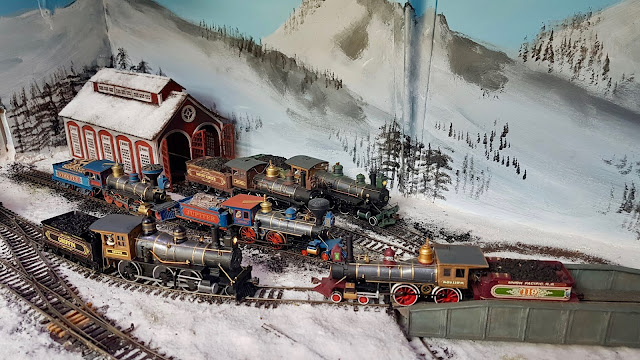I mentioned in my "what's the intent?" post that I think people are the reason railroads exist. In 1895 people were much more connected to rail transport than they are today. The train was 'the' way you travelled any long distance. If you were going on holiday, travelling for business or shipping goods, you used the train. One way I've tried to capture this aspect of turn of the century life is by populating the layout with figures and animals.
I'm really blessed that my father's hobby is painting wargaming miniatures, particularly from the American Civil War and Old West eras. Because of this, he very generously paints all manner of figures for my layout and I think he does a superb job.
Dad uses Humbrol matt paints almost exclusively and patiently hand paints each figure. He works in batches, painting various figures in stages, working through the flesh colours, then various parts of the clothing. His hand is far steadier and more accurate than mine, allowing him to add fine details like check shirts, flowers in headdresses and in some cases, even pupils in the figure's eyes.
 |
| A pack track from Musket Miniatures Rustic Rails line. |
 |
| A mixture of Blue Moon, Knuckleduster, AC Stadden and Musket Miniatures figures make up the inhabitants of Cass. |
 |
| Figures and horses from Musket Miniatures work at the Teresaton livery stables. |
Many store-bought, prepainted figures can appear flat and featureless. Dad uses a dry brushing technique to highlight details, bringing the figure to life. Dry brushing makes ruffles in a dress, cresses in a suit, buttons, or even individual fingers on a hand, far more apparent.
Dry brushing is also a really good way of adding dirt and dust to a figure, most people today, let alone in the Old West, don't look like they have just stepped out of a clothing shop.
By using matt paints, Dad also avoids the unrealistic sheen of many prepainted figures. At a distance, even shiny surfaces are not as glossy as they close up. Our models are generally viewed from several hundred scale feet away, so it can be appropriate to tone the colour intensity and sheen down. Subsequently, Dad's figures fit naturally into the scenery.
 |
| TOC19 children by A C Stadden, outside Teresaton school. |
 |
| A cougar stalks on the cliff tops. This was a 3D printed miniature from Shapeways. |
 |
| Bank robbers encounter lawmen at a bank heist by Blue Moon Miniatures. |
Over the last ten years, Dad has painted several different brands of turn of the century figures. The majority of my figures come from
Musket Miniatures Rustic Rails product line. The business changed hands several years ago and unfortunately, the new owner has not continued to offer the rustic rails line on their website. I understand they acquired all the moulds, though I have not enquired as to if they plan to produce any.
I also have figures from
Blue Moon miniatures. These are 15mm wargaming figures and are a little small for HO. However, interspersed with other brands, help vary the average height of the population.
AC Stadden makes several lines of fantastic Edwardian and Victorian civilian people in everyday and fancy dress. They are beautifully detailed and paint very well. They are quite fine, or slim, which also helps with the variety of body shapes in the population.
By far the most impressive figures we've seen are those on offer from
Knuckleduster Miniatures. Sculptor Forrest Harris has made masters using 3D printing, which he uses to cast the lead-free pewter miniatures. The detail is finer than anything else we've seen in HO Scale figures. Buckles, individual fingers, facial expressions, and eye details are just par for the course in Knuckledusters figures.
 |
| Musket Miniatures figure on the left, Knuckleduster on the right. |
 |
| Two TOC19 figures by A C Stadden, with two Blue miniatures figures in the background. |
The most recent census of the layout revealed there are 270 people on the layout. If you were to add all the cattle, horses, and wild animals like bison, elk, moose, skunks and coyotes, the final tally would easily be close to 350. Some may say this is too many. I have thought this myself at times. However, I believe it really gives the impression there are bustling towns and industries that need the railroad to survive.
Some modellers have a preference for figures or animals in at rest poses as opposed to active poses. The thinking is that figures in action poses are frozen in that position forever like some fairy tale nightmare and may appear unrealistic.
I don't mind the frozen action. I find it helps convey the story of what life was like in 1895. Visitors to the layout tend to be drawn in by the detail. Their intrigue shows they are quite accepting of the fact they are frozen in time, they have fun looking for the story in the scene.
 |
| Wagon teamsters by Knuckleduster Miniatures. |
Thanks, Dad for making such a huge contribution to the layout. Truly, without the figures, I believe the layout would not have the impact or the interest it does.
| Manufacturer | Number |
| AC Stadden | 54 |
| Preiser | 14 |
| Bachmann | 13 |
| Knuckleduster | 36 |
| Blue Moon | 57 |
| Musket Miniatures | 93 |
| Other | 3 |
| 270
|












































